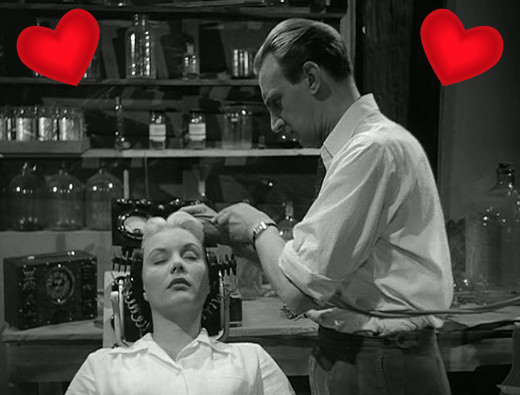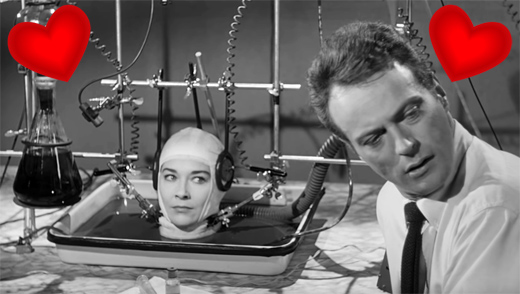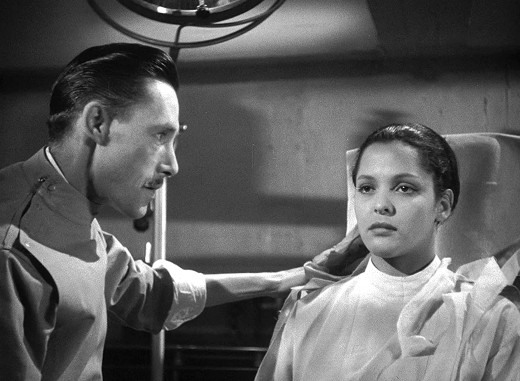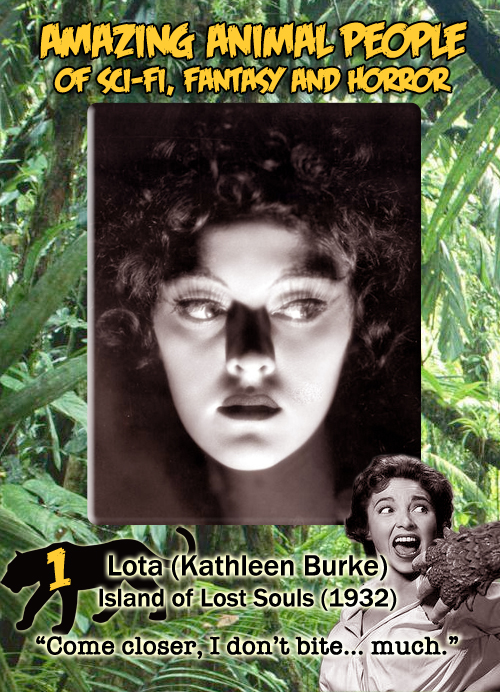At first glance, B-movie mad doctors would not seem to be a natural subject for a Valentine’s Day post. As I pointed out in "The Best Laid Plans of Not-so-nice Madmen," most mad doctors were far too busy stitching together body parts or trying to create armies of zombies to pursue any sort of amorous relationship.
They reserved their passions for proving their insane theories, wreaking revenge on the colleagues who laughed at them, and showing the world their brilliance. And they were often willing to sacrifice anyone, including friends, family and would-be lovers, in their demented quests.
Still, not every mad doctor of the movies was immune from Cupid’s arrows. A select few became mad and used their knowledge for evil because of lost or frustrated love.
To celebrate the occasion, Films From Beyond presents Valentines from a scattered assortment of oddball, passionate B-movie doctors who, unlike many of their crazy colleagues, did it all for love.
Dr. Gogol and Yvonne Orlac, Mad Love (1935)
 |
| "I have conquered science, why can't I conquer love?" |
Dr. Gogol (Peter Lorre), an accomplished surgeon, is obsessed with theater actress Yvonne (Frances Drake), attending all of her performances at the 'Théâtre des Horreurs' in Paris. He is devastated when he learns that Yvonne plans to quit the theater to marry concert pianist Stephen Orlac (Colin Clive) and move to England.
Unhinged, Gogol buys a wax figure of Yvonne from the theater, setting it up in his home and talking to it as if it were alive. When Stephen’s hands are mangled in a train accident, Yvonne, knowing of Gogol’s reputation as a top surgeon, pleads with him to help her husband. Gogol uses the hands of a recently executed murderer -- Rollo, a skilled knife thrower -- in a transplant operation.
Orlac’s new hands are useless for playing the piano, but he finds he’s now very good at throwing knives. Gogol tries to convince Yvonne to leave her husband as Stephen’s mental state deteriorates. Yvonne stands by her man, but the deranged surgeon will try anything, including posing as the resuscitated murderer Rollo, to break up the couple and have her all to himself.
Fun Fact: Mad Love is based on Maurice Renard’s novel The Hands of Orlac (Les Mains d'Orlac, 1920). It was the second film adaptation of the novel -- a silent version was released in 1924. The novel would be adapted four more times (the last, Roxana’s Hands, 2012, switches Orlac’s gender and makes her a concert violinist).
 |
Countess Lorenz: "Can you bear to look at me now?"
Dr. Lorenz: "Of course, you are beautiful, and I shall always keep you that way!" |
Police are baffled when blushing brides start collapsing at the altar and their bodies disappear on the way to the morgue. Intrepid reporter Patricia Hunter (Luana Walters) traces the deaths and disappearances to mysterious orchids that were delivered to each wedding.
When she consults a renowned orchid specialist Dr. Lorenz (Bela Lugosi), she stumbles on his fiendish plot to extract glandular fluid from the brides to keep his aging wife (Elizabeth Russell) young and beautiful. Hunter has to fend off Lorenz and his minions, a demented housekeeper and her two thuggish sons, to keep from being the next supplier of the anti-aging elixir.
Fun Fact: Just a year later in The Ape Man (1943), Bela portrayed yet another mad doctor messing around with bodily fluids -- this time spinal fluid -- in order to reverse the effects of an experiment gone wrong. See "The Best Laid Plans of Not-so-nice Madmen."
 |
| "In all my life I've only wanted two things -- knowledge and... love. I used the first to try and gain the second." |
Childhood friends Robin Grant (John Van Eyssen) and Bill Leggat (Stephen Murray) have made the scientific big-time. After getting degrees at Cambridge, they have returned to their tiny English village to work on a secret project: a matter duplicator.
They demonstrate their invention to the village doctor (James Hayter) and Robin’s rich father (Percy Marmont), duplicating the doctor’s watch and a bank check down to the smallest detail.
However, there is a cloud on the horizon. A third childhood friend, beautiful Lena Maitland (Barbara Payton), has returned from an extended stay in America. Although Bill has secretly been in love with Lena all his life, to his dismay Lena falls for Robin and they get married.
Bill redoubles his efforts to figure out how to duplicate living organisms while Robin is away in London consulting with government authorities on their invention. He finally perfects the process, and convinces Lena to submit to being duplicated in the mad hope that he can have his Lena and Robin can have one too.
Except there’s a catch: the duplicate Lena, renamed Helen, is exact in every detail… including her feelings for Robin.
Not-so-Fun fact: Somewhat like Lena, the beautiful Barbara Payton was used to having men compete for her affections. The most notorious instance was when actors Tom Neal and Franchot Tone had a knockdown, drag-out fight over her, which sent Tone to the hospital.
After all the bad publicity, Payton traveled to the UK to jumpstart her flagging career, making a couple of B movies, including Four Sided Triangle, for the fledgling Hammer Films. It was nothing doing -- by 1955 her short-lived film career was over.
 |
| "I want you as a complete woman, not part of one. Is it a crime to want to keep you alive?" |
Dr. Bill Cortner (Jason Evers) is an arrogant, hotshot young doctor who insists that lives can be saved with new, experimental techniques. Although Bill proves himself by saving the life of a man everyone had given up for dead, his father, also a surgeon, is uncomfortable with the idea of using people as guinea pigs.
Bill gets a call from his lab assistant Kurt (Anthony La Penna) telling him that there’s an emergency in the lab located at the family’s country house. Bill, along with his fiancee Jan (Virginia Leith), races off in his souped up convertible. His lead foot results in tragedy when he fails to negotiate a sharp turn and the car crashes down a ravine.
Bill has been thrown clear, but when he recovers and checks the wreckage, he’s horrified to find that Jan has been decapitated. The panicked doctor wraps Jan’s head in a blanket and runs the rest of the way to the lab, where he sets up the head in a tray and feeds it a serum he’s invented to keep it alive.
Jan wants to die, but Bill won’t let her go so easily. He’s confident that the new serum will enable him to transplant Jan’s head onto a new body. While he goes body-shopping at the local strip club (naturally!), Jan, now telepathically charged due to the serum, is making friends with the horrific failed experiment -- a thing made up of discarded body parts -- that Bill has locked up in a closet.
Fun Fact: Since 2009, The Brain that Wouldn’t Die has inspired no fewer than four (!) stage musical adaptations and one movie re-make.
 |
| "My love, sweet queen and noble wife, I alone remain to bring delivery of your pain. Severed my darling, too quickly from this life. Of fires drawn and memories met, I shall hold our two hearts again in single time." |
In 1920s London, prominent physicians are being murdered in bizarre ways: one by an infestation of bats, another by an ingenious frog mask designed to choke the wearer to death, and yet another has had every ounce of blood drained from his body.
Following up on a clue -- a strange amulet left at the scene of one of the murders -- Scotland Yard Inspector Trout (Peter Jeffrey) learns from a Rabbi that the symbol on the amulet represents the ten Old Testament curses inflicted upon ancient Egypt.
As the bodies pile up, Trout figures out that all of the victims worked under Dr. Vesalius (Joseph Cotten). Vesalius soon meets the scourge of the London medical community -- Dr. Anton Phibes (Vincent Price), inventor, concert organist and all-around Renaissance monster.
It seems Phibes, who had supposedly died in a car accident, blames Vesalius and his surgical team for the death of his beloved young wife on the operating table. And the hideously disfigured Phibes is determined to visit one more Old Testament plague on Vesalius in retribution.
Fun Fact: ‘70s scream queen and Bond girl Caroline Munro appears (uncredited) in a non-speaking role as Anton Phibe’s dead wife, Victoria.














